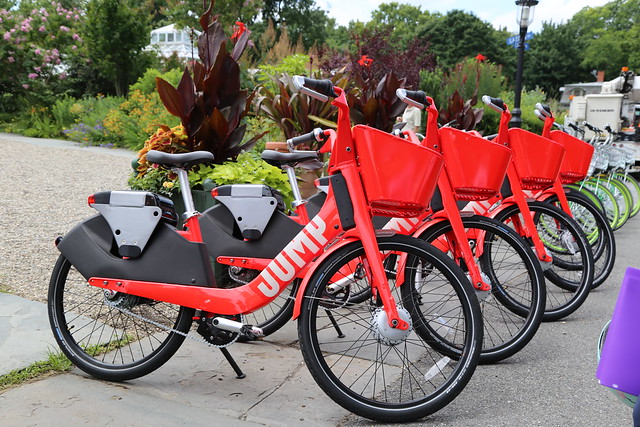Staten Island Gets More Dockless Bike-Share — But Not Bike Lanes
It's a bit weird, considering that Staten Island does not have a single street with a protected bike lane on it.

Staten Island is about to get a hell of a lot more bikes — but Mayor de Blasio has not guaranteed cyclists a safe place to ride.
The Department of Transportation announced Monday that it is seeking multiple companies to participate in expanding Staten Island’s dockless bike-share pilot to the full borough — an increase from the limited North Shore zone that launched in July.
The city hopes multiple companies will also participate in the borough-wide pilot, according to a Request for Expressions of Interest posted on the city website [PDF]. Applications are due by May 22, with the expanded zone expected to launch in July.
“In last year’s pilot, we learned that Staten Islanders love bike share, and we often found that their rides sometimes drifted outside of the North Shore boundaries we set last summer,” DOT Commissioner Polly Trottenberg said in a statement. “So now that riders have voted with their feet, we want to have the entire island to be available to them.”
Unlike the docked Citi Bike system, which only covers parts of Manhattan, Brooklyn, and western Queens, dockless bikes lock to themselves and can be left anywhere. Last summer, the city allowed a handful of dockless bike companies pilot their services far from the current Citi Bike zone — in contained areas of the Bronx, the Rockaways, and Staten Island.
Before last summer’s pilots, Citi Bike had a bike-share monopoly in New York City. It still holds a monopoly in its current service area of larger parts of Manhattan and Brooklyn, and a sliver of Queens.
Both Lime and the Uber-owned Jump — which participated in the Staten Island pilot — clearly hope the borough-wide expansion will open the door for them to grow into more areas not currently served by Citi Bike, which has a monopoly over its current coverage area.
“We hope that, very soon, all New Yorkers will have access to dock-free bikes and scooters — so that anyone can get around their city easily, regardless of income or zip code,” Phil Jones, senior director of east coast government relations and strategic partnerships at Lime, said in a statement related to the Staten Island announcement.
Last year’s North Shore rollout was not without its hiccups. In August, the Jump bikes, which have the added benefit of being pedal-assist e-bikes, mysteriously failed to show up on its mobile app — rendering the program useless. And Lime’s electric bikes frequently lost power.
The borough’s total lack of safe cycling infrastructure remains an issue. In all of Staten Island, there is not one single on-street protected bike lane, and the further one gets from the densely-populated North Shore, the less conducive the streets are for walking and biking.
“You can give people as much access to bicycles as you can, but if we don’t have a safe place to ride, people aren’t going to do it,” said Transportation Alternatives Staten Island organizer Rose Uscianowski. “There are so many areas on Staten Island that don’t have the infrastructure. There are streets in Staten Island where you can barely walk.”

Staten Islanders have taken 61,000 bike-share trips courtesy of Lime and Jump since the pilot began, according to DOT data — more than other dockless pilot areas in The Bronx and the Rockaways, said Uscianowski.
Buses and cars are the only option for Staten Island residents not living near the Staten Island Railroad. The proliferation of bikes has made it easier to get in and out of the busy St. George neighborhood, home of the Staten Island ferry terminal.
“It kicked off because it was an option to give people an alternative mode of traveling,” said Peter Lisi, a small business owner who serves on the leadership of the Van Duzer Street Civic Association. “I use it occasionally to go to Borough Hall to pay taxes or to pay a ticket, rather than starting my car and getting stuck in traffic. The worst part of traffic is looking for a parking spot, especially in St. George.”
Citi Bike launched in 2013 in parts of Manhattan that already had a significant network of protected and unprotected bike lanes, in stark contrast to the present situation in Staten Island.
“A big part of Citi Bike’s success out of the gate was because it came on the heels of progress on the bike lane network in the initial service area. We have a less strong sense of DOT’s plans to make Staten Island streets more welcoming and safe for bicycling,” said Bike New York Communications Director Jon Orcutt, who served as DOT’s policy chief at the time of the initial bike-share rollout.
Cycling advocates have pushed for a citywide expansion of the docked Citi Bike system, which is owned by Lyft and has exclusive operating rights within its current service zone. In November, the city announced that Lyft would double the system’s geographic reach while maintaining its monopoly. Lime, Jump and other companies have been demanding access to the broader bike-share market.




